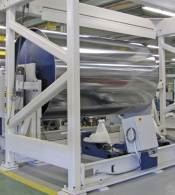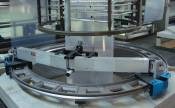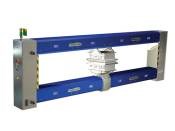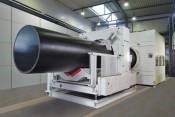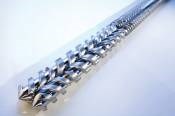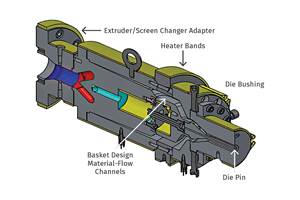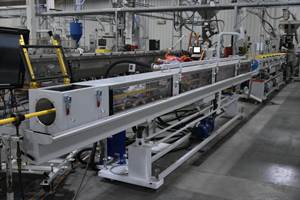NPE News in Extrusion
This NPE show won’t have a lot of extruders on the floor, either running or static. Instead, look for videos and announcements of new technology. You will also find lots of ingenious peripheral devices to improve output and quality and save resin. Some will do all three, and cost less into the bargain.
SUPER-FAST STRETCH FILM
Among the most dramatic new technologies to be announced at NPE (but not shown) are two stretch-film winders expected to wind LLDPE at 3000 ft/min or more. Currently, the fastest stretch-film winder is the four-spindle S4 from Davis-Standard’s Converting Systems Group, which can run at 2400 ft/min. At that speed, stretch-film output is limited by the winder, but at 3000 ft/min, extruder capacity is more apt to be the limiting factor.
Both new winders wind trimless finished rolls, not master rolls. The more unusual of the two is Gloucester Engineering’s WOW winder, which is strikingly different in concept from anything else. The 120-in.-wide WOW will wind eight 15-in. finished rolls every 4 sec. Gloucester built the prototype shortly before K 2007 in Germany (U.S. Pat. Applic. 2008011825) and showed the concept to selected customers, but not the public at large. Now Gloucester has built and sold the first commercial model for delivery in June after the show. The winder will run at Gloucester’s plant with live video feed to NPE, but even the video will be viewable only by invitation.
WOW consists of a giant custom-built take-up drum of 7-ft diam., which can be air-cooled for use in hot environments. The large diameter is needed to keep air out of the rolls as they’re being wound. Stretch film is slit into eight lanes before it reaches the take-up drum at about the eight o’clock position, wraps around the drum, and is taken off onto eight turret-type spools. The spools are arranged in alternating high and low positions (at two and four o’clock) downstream on the drum. Each spool has three stations—winding, unloading, and new core waiting. Spools can also wind coreless and be adjusted laterally for different roll widths. Rolls are automatically unloaded and cores replaced by two six-axis industrial robots from Motoman. Each robot serves four spools.
The second new high-speed stretch-film winder is from SML Extrusion Technology in Austria, which won’t have actual equipment at the show. The unnamed winder incorporates upgrades and improvements to SML’s previous turret winder and has been tested at 3300 ft/min. The first unit will be delivered in July to produce finished 500-mm rolls four up. It was sold with a new 90-mm-diam. extruder designed for moderately high rpm and outputs of over 2200 lb/hr—also a record for stretch film. The extruder uses a special water-cooled asynchronous AC motor from Elin EBG Motoren GmbH (Weiz, Austria), which reportedly converts electricity with 95% efficiency. The extruder has a new low-ratio gearbox to reduce motor noise and vibration.
Davis-Standard’s S4 stretch-film winder has also been widened from 120 to 136 in. The 120-in. model produces six 20-in. rolls every 25 sec or a roll every 4.14 sec. The 136-in. version winds U.S. hand-wrap sizes—such as eight 16-in. or twelve 11-in. rolls. For master stretch-film rolls, Davis-Standard also widened its PAC 60 surface winder from 80 to 140 in.
For film that has different layers or treatments on each side, Macro Engineering & Technology just built its first Automax-SBG surface winder, which can reverse direction to wind rolls with either side out. This is also Macro’s first winder with a new cutting system using a rotating knife that fits in a groove on the drum.
CAST FILM & SHEET
You’ll also see several new concepts in direct-drive extrusion, aimed at lowering the cost of high-speed synchronous torque motors. Welex will introduce the HS 300 high-speed (1500-rpm), 3-in. sheet extruder. It is the first to use a conventional air-cooled, variable-speed, 600-hp AC motor (from ABB) without a gearbox, instead of a water-cooled synchronous torque (“syn-torque”) motor.
Other atypical features of the HS 300 are high-volume feeding, 40:1 L/D, and a vent. Together these allow it to achieve outputs up to 6000 lb/hr of PP, Welex reports. The vent is to prevent air entrapment at high feed rates. The new extruder will be exhibited in a static display next to Welex’s 6-in. conventional extruder, also capable of 6000 lb/hr. European high-speed sheet extruders are typically just under 3-in., 36:1 models that run at 1000 to 1500 rpm and use more expensive permanent-magnet syn-torque motors or four-motor torque drives.
Another new concept in direct drives is syn-torque motors designed to maximize energy efficiency instead of throughput by running at lower speed (100 to 200 rpm). Davis-Standard put a 50-kw, 100- to 150-rpm syn-torque motor from Baumuller on a 2.5-in., 30:1 extruder. The motor reportedly has higher voltage and lower amperage, making the drive less expensive than low-voltage, high-amperage versions.
Davis-Standard ran comparison trials of the same direct-drive extruder, screw, and resin with either a standard DC motor, a standard variable-speed AC motor, or Baumuller’s syn-torque motor. All motors had the same kw rating and ran at the same rpm. Davis-Standard put watt meters on the individual leads to measure actual energy consumption for the comparison. Results are expected to be available at NPE.
Processing Technologies International (PTi) will display a new modular Globaline sheet extruder for inline or offline thermoforming. Lines are designed for either of two sheet widths (1000 or 1500 mm) and can be configured for one, two, or three layers. Special features include built-in ratchet wrenches to open and close four roll-gap points and to adjust roll-stand height relative to the die lips. PTi will display the Globaline G4500 extruder (4.5 in.) with a roll stand for 1500 lb/hr of sheet.
In the growing field of micro-layer extrusion, Davis-Standard’s lab line in Pawcatuck, Conn., will be shown at NPE with a layer-multiplying feedblock from Extrusion Dies Industries (EDI) that can make hundreds of layers. As discussed in our May issue, it repeatedly multiplies a layer structure fourfold; so, for example, a three-layer structure becomes 12, 48, 144 layers, and so on. The lab line also has an adapter that can inject gas to foam skin layers around a micro-layer structure.
Cloeren will show sample film rolls and other micro-layer products in its booth. The firm recently installed a micro-layer feedblock in Europe on a five-extruder stretch-film line making highly puncture-resistant pallet wrap with over 25 layers.
BLOWN FILM NEWS
This show will be notable for the absence of tall blown film towers with bubbles high in the air. Only one exhibitor is expected to actually run blown film at NPE—Lung Meng Machinery Co. from Taiwan plans to have two lines running. The emphasis at the show will be more on components and auxiliaries.
For example, show visitors will have ample opportunity to learn why dual air rings are currently popular for some (though not all) applications. Older three-layer coex lines that are cooling limited may add 20% to output with dual air rings. Tandem rings also improve optical clarity in shrink film. But they require long production runs because startup takes much longer. All vendors supply motorized upper rings and automatic gauge control, but they don’t all offer the same range of sizes.
Starting at the large end, Macro Engineering, which held the original patent on tandem air rings and built the first as early as 1983, will display its Binary air ring at NPE for the first time. Macro’s unique approach uses a dual lip on both rings, whereas all other makers use a single lip on the lower ring and dual lip on the upper. Macro also builds them for the largest dies—up to 2 meter diam.
Kiefel Extrusion in Germany, which built an early tandem air ring for high-stalk HDPE in the mid-1990s, won’t show its new PerfectCool Dual at NPE but will have experts available to discuss it. Kiefel builds it for up to 750-mm dies.
Hosokawa Alpine from Germany will have graphics and a video of its tandem air rings at NPE. The dual rings, demonstrated at K 2007 in Dusseldorf, have been built for up 560-mm dies, but could be made up to 630-mm.
Dolci Extrusion in Italy (represented here by Kampf Machinery) recently developed a dual air ring for up to 400-mm dies.
Plast Control from Germany will show its Pro-Con Duo air ring for the first time in the U.S. It was introduced at K 2007 and has a special lip set with no blow-up ratio on the lower air ring. It’s is offered for up to 400-mm dies.
Macchi from Italy will show elements of a three-layer coex extruder and die assembly (65/80/65 mm) with gearless motor drives, 300-mm die, IBC, and Macchi’s recently introduced carbon-fiber CR2 dual air ring (reported in our May issue). It’s available for up to 350-mm dies.
You’ll also hear about several new, inexpensive, but still good quality, blown film lines. Kiefel has developed a modular German-built line called “e.co.s” (efficient coextrusion system). The complete three-extruder coex line, designed for Asian and Eastern European markets, includes a film tower for up to 1600-mm layflats. The first system was sold recently to India.
Guang Dong Jin Ming of China (represented here by PEC Plastic Equipment Co.) offers inexpensive high-layer coex lines together with some top-quality European gauges and controls. Jin Ming delivered eight 7-layer barrier film lines last year to China with auto-gauging controls from B&R Automation, gravimetric feeding systems from Inoex, and high end Kundig S100 dual capacitance gauges on the layflat.
Meanwhile, D.R. Joseph is developing a new “economy” IBC system with more features than the company’s previous low-priced model—particularly tighter layflat control. The new IBC, which may be at the show, has layflat control, touchscreen interface, two standard IBC sensors, and two standard layflat sensors (four of each are optional). It is said to be easier to install than the previous version, and has new automatic valve calibration. (IBC valves typically must be recalibrated every year.) D.R. Joseph is also introducing a new layflat sensor that costs 40% less than its previous one, for use with both IBC and non-IBC lines.
(Show news in gravimetric extrusion controls from Addex Inc. and Conair were discussed in our May issue.)
GAUGING & INSPECTION
Two new thickness gauges for blown film aim at faster measuring. Kundig (U.S. office in Grand Prairie, Texas) will show a new “hinging arm” frame for rotating scanners, called Rotomat KT. When used with Kundig’s K-300 contact gauge, introduced at K 2007, it can move continuously in one direction around the bubble in as little as 36 sec for bubbles up to 98 in. diam.
Rotomat KT uses industrial Blue Tooth wireless data communication and a sliding electrical contact for power supply. The frame also costs considerably less to build than Kundig’s previous frame, because only four different sizes can be used to measure film between 10 and 154 in. layflat.
Because a flat scanner can calculate film profile much faster than a bubble-mounted rotating gauge, Macro Engineering has also developed a new gauge for the layflat. Its D10 PROflat uses an IR scanner from Thermo Fisher Scientific, and can provide not only the total thickness profile, but also individual thicknesses of up to four layers. Software from Thermo Fisher calculates primary nip randomizing of film on the layflat, allowing adjustments of the air ring to control gauge.
Both individual layer thicknesses and overall thickness of multilayer films and coatings are measurable on line with the new StraDex 80 noncontact sensor from ISIS sentronics GmbH in Germany. Recent enhancements of the firm’s patented SCI (spectral coherence interferometry) near-infrared gauging technology have reduced minimum layer thickness from the previous 12 microns to 4 microns, and sample rate has been boosted to 20 kHz, allowing tracking speeds of up to 1000 m/min. Because StraDex works in reflection mode, it can measure coatings on clear substrates; it can even handle slightly opaque layers. StraDex 80 reportedly can compensate for sample movement.
Two other new thickness gauges for flat film offer breakthroughs in measuring film without a constant air gap. One is a beta gauge, the other a capacitance type, but both use a principle of rapid double measurements to cancel the effect of web movement.
Mahlo of Germany will show its QMS-12 Web Quality Control System in the U.S. for the first time. The unusual component is the Dynamic Flutter Independent beta sensor, which measures film moving anywhere within a 2 in. gap. The detector measures beta particles (electrons) at different locations across its face so it’s not affected by web flutter or curl. For the transmitter side, Mahlo offers three different low-energy isotopes for films of different thicknesses: promethium for up to 10 mils, krypton for up to 40 mils, and strontium for up to 250 mils.
Meanwhile, Plast Control developed its first noncontact capacitance gauge using a patented approach with two small gauges side by side. They take two measurements, allowing the gauge to calculate film thickness even if the air gap varies.
For pipe, Zumbach Electronics Corp. will introduce a new high-speed camera-based surface-quality inspection system called Simac 63 (for pipe up to 63 mm diam.). It uses three high-speed cameras arranged 120° apart for 100% circumferential inspection. Each camera makes 35,000 scans/sec, detecting color or surface changes, gels, cracks, or other visible defects down to 0.004 in., at over 1500 ft/min.
ISRA Surface Vision from Germany will show its Powerscan plastic sheet inspection system for the first time. Powerscan was brought out 18 months ago for inspecting plate glass. Now it’s being introduced to inspect and grade the quality of clear and opaque plastic sheet.
Dr. Schenk of Germany will show its EasyInspect optical inspection system for the first time in the U.S. EasyInspect was introduced at K 2007 as a less expensive, modular version of Dr. Schenk’s custom WebFeat inspection system. EasyInspect has high-speed CCD camera arrays that detect gels, voids, scratches, and other film defects as small as 50 mils.
NDC Infrared Engineering is showing TDi 8110-BF, its first distributed gauge control system for blown film. TDi (total distributed intelligence) was first introduced in 2006 for gauge control of flat webs. The new system works with any fixed or moving NDC thickness sensors on the bubble or layflat. It also includes data-management screens that display trends, reports, SPC, FFT (fast Fourier transform), and polar plots of thicknesses of up to four layers.
NEWS IN PIPE AND PROFILE
Welex will also introduce a simple, inexpensive direct-drive Econotruder with AC motors for medical tubing and small profiles with AC motors and direct drive. It runs at a conventional 175 rpm and comes in three extruder sizes: 2 in. with 20-hp motor, 2.5 in. with 40 hp, and 3.5 in. with 75 hp. Otherwise, it offers no options.
Siemens in Germany redesigned one size of its four syn-torque motors (280-mm shaft height), making it 30% more energy efficient than before. The upgraded 280 motor can be optimized for torque from 2000 to 7000 Nm and standard speeds of 150, 200, 400, and 600 rpm (it can go up to 1000 rpm).
Reifenhauser uses the redesigned Siemens 280, optimized for 150 rpm. Kuhne GmbH and American Kuhne are using it optimized for 250 and 400 rpm.
Cincinnati Extrusion in Austria (represented here by American Maplan) will highlight optimized Polytherm screw flight geometry said to provide 10% higher output for its Argos parallel twin-screw extruder for PVC pipe and profile.
American Maplan also announced plans to build its largest HDPE pipe extrusion line so far, for up to 78 in. diam. Maplan’s largest HDPE line to date was for 63-in. pipe.
To reduce wear and extend screw life, Wear Technology, the division of Cincinnati Milacron that builds and repairs conical and parallel twin screws and barrels, is field testing new metal coatings for high-wear areas on the screw and barrel to improve corrosion and abrasion resistance.
To control thickness and diameter of wire, cable, pipe, and tubing, Beta LaserMike is showing a new mid-range industrial controller, DataPro 3100 with a 5.7-in. touchscreen. It can monitor and control any two laser diameter or thickness gauges and includes a shrinkage calculation.
(Additional new developments at the show for pipe and tubing from Inoex, LaserLinc, Cincinnati Extrusion, and Guill Tool were reported in our May issue.)
TEMPERATURE & PRESSURE
For inexpensive process control, Dynisco Instruments will show its recently introduced Opt-Trol multi-loop controller for the first time at any show. As we reported in February, Opt-Trol controls eight temperature and two pressure loops and can be expanded to up to 40 temperature zones. Also shown for the first time will be Dynisco’s SPX-T pressure sensor with an integrated temperature sensor. It compensates for high temperatures, which reportedly makes pressure measurement more accurate.
Gneuss is introducing its new NTX mercury-free pressure transducers to the American market at NPE. They use a different fluid than other mercury-free transducers. Gneuss claims they last longer in high-temperature environments.
Related Content
High-Speed Cutters for Corrugated Tubing
Applications for new cutter line include medical, automotive, and other industrial.
Read MoreHow to Effectively Reduce Costs with Smart Auxiliaries Technology
As drying, blending and conveying technologies grow more sophisticated, they offer processors great opportunities to reduce cost through better energy efficiency, smaller equipment footprints, reduced scrap and quicker changeovers. Increased throughput and better utilization of primary processing equipment and manpower are the results.
Read MoreHow to Select the Right Tooling for Pipe Extrusion
In pipe extrusion, selecting or building a complementary set of tooling often poses challenges due to a range of qualitative factors. Here’s some guidance to help you out.
Read MoreTeel Adding Capacity, Bumping Pay for Hourly Workers
Teel growing to meet market demand, meaning increased employment opportunities for the area.
Read MoreRead Next
Understanding Melting in Single-Screw Extruders
You can better visualize the melting process by “flipping” the observation point so that the barrel appears to be turning clockwise around a stationary screw.
Read MoreTroubleshooting Screw and Barrel Wear in Extrusion
Extruder screws and barrels will wear over time. If you are seeing a reduction in specific rate and higher discharge temperatures, wear is the likely culprit.
Read MoreWhy (and What) You Need to Dry
Other than polyolefins, almost every other polymer exhibits some level of polarity and therefore can absorb a certain amount of moisture from the atmosphere. Here’s a look at some of these materials, and what needs to be done to dry them.
Read More



